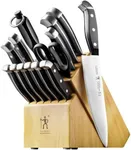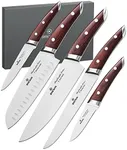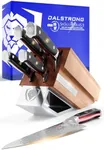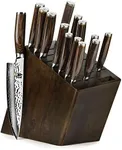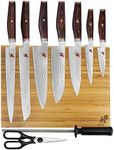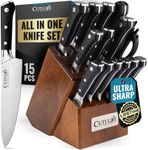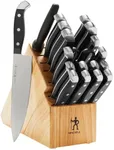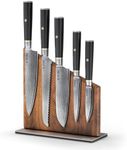Buying Guide for the Best Chef Knife Sets
Choosing the right chef knife set is crucial for any cooking enthusiast or professional chef. A good set of knives can make food preparation easier, safer, and more enjoyable. When selecting a chef knife set, it's important to consider several key specifications to ensure you get the best fit for your needs. Here are the main factors to consider and how to navigate them.Blade MaterialThe blade material of a knife affects its sharpness, durability, and ease of maintenance. Common materials include stainless steel, high-carbon stainless steel, and ceramic. Stainless steel is resistant to rust and easy to maintain, making it a good choice for everyday use. High-carbon stainless steel is harder and holds an edge longer but requires more care to prevent rust. Ceramic blades are extremely sharp and lightweight but can be brittle and prone to chipping. Choose a blade material based on your cooking habits and willingness to maintain the knives.
Handle MaterialThe handle material impacts the comfort and grip of the knife. Common handle materials include wood, plastic, and composite. Wooden handles offer a traditional look and feel but require more maintenance to prevent cracking and warping. Plastic handles are durable and easy to clean but may not provide the best grip when wet. Composite handles combine the benefits of both wood and plastic, offering durability and a comfortable grip. Consider how the handle feels in your hand and how much maintenance you're willing to perform.
Knife Types IncludedA chef knife set typically includes several types of knives, each designed for specific tasks. Common knives in a set include a chef's knife, paring knife, bread knife, utility knife, and slicing knife. A chef's knife is versatile and can handle most tasks, while a paring knife is ideal for small, precise cuts. A bread knife has a serrated edge for slicing through bread without crushing it. A utility knife is a smaller, all-purpose knife, and a slicing knife is designed for cutting thin slices of meat. Consider the types of food you frequently prepare and ensure the set includes the knives you need.
Blade LengthBlade length affects the knife's versatility and ease of use. Chef's knives typically range from 6 to 12 inches in length. Shorter blades (6-8 inches) are easier to control and maneuver, making them suitable for smaller hands or detailed work. Longer blades (10-12 inches) provide more cutting surface and are better for larger tasks like slicing through big cuts of meat or large vegetables. Choose a blade length that feels comfortable in your hand and suits the types of tasks you perform most often.
Weight and BalanceThe weight and balance of a knife affect how it feels in your hand and how easy it is to use. A well-balanced knife will have its weight evenly distributed between the blade and the handle, making it easier to control and reducing hand fatigue. Heavier knives can provide more cutting power but may be tiring to use for extended periods. Lighter knives are easier to handle but may require more effort to cut through tough ingredients. Test the weight and balance of a knife by holding it and performing a few cutting motions to see what feels most comfortable for you.
Edge Retention and SharpeningEdge retention refers to how long a knife stays sharp before needing to be sharpened. Knives with good edge retention require less frequent sharpening, saving you time and effort. High-carbon stainless steel and ceramic blades typically offer better edge retention than regular stainless steel. However, all knives will eventually need sharpening. Consider how often you're willing to sharpen your knives and whether you have the tools and skills to do so. Some sets come with a sharpening tool or honing steel to help maintain the edge.
